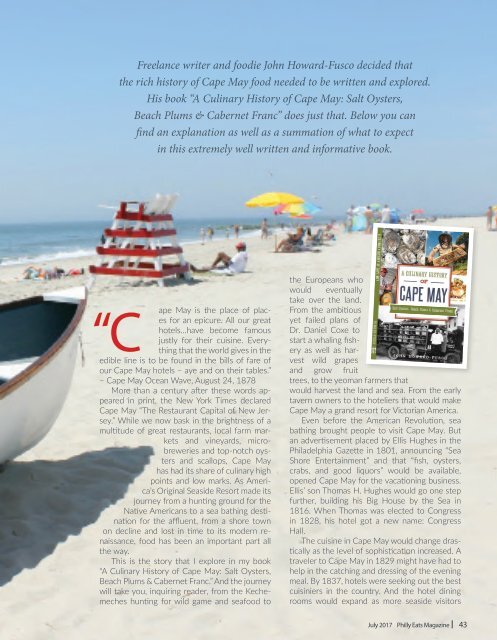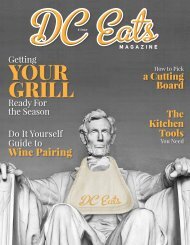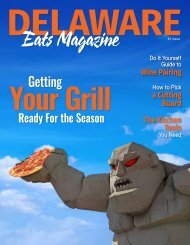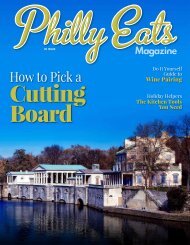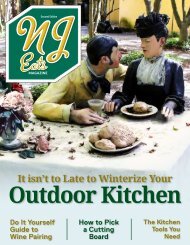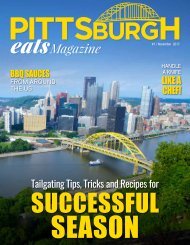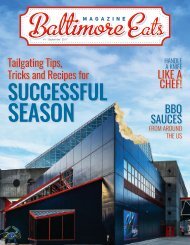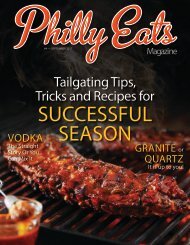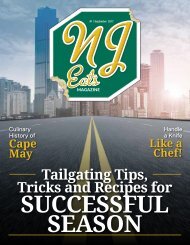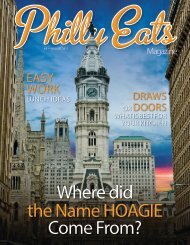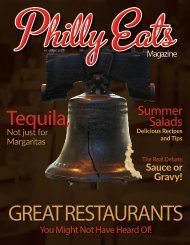Philly Eats Magazine Second Edition 2017
The July Edition of Philly Eats includes a feature on the home of the Phillies Citizens Bank Park.
The July Edition of Philly Eats includes a feature on the home of the Phillies Citizens Bank Park.
You also want an ePaper? Increase the reach of your titles
YUMPU automatically turns print PDFs into web optimized ePapers that Google loves.
Freelance writer and foodie John Howard-Fusco decided that<br />
the rich history of Cape May food needed to be written and explored.<br />
His book “A Culinary History of Cape May: Salt Oysters,<br />
Beach Plums & Cabernet Franc” does just that. Below you can<br />
find an explanation as well as a summation of what to expect<br />
in this extremely well written and informative book.<br />
“C<br />
ape May is the place of places<br />
for an epicure. All our great<br />
hotels…have become famous<br />
justly for their cuisine. Everything<br />
that the world gives in the<br />
edible line is to be found in the bills of fare of<br />
our Cape May hotels – aye and on their tables.”<br />
– Cape May Ocean Wave, August 24, 1878<br />
More than a century after these words appeared<br />
in print, the New York Times declared<br />
Cape May “The Restaurant Capital of New Jersey.”<br />
While we now bask in the brightness of a<br />
multitude of great restaurants, local farm markets<br />
and vineyards, microbreweries<br />
and top-notch oysters<br />
and scallops, Cape May<br />
has had its share of culinary high<br />
points and low marks. As America’s<br />
Original Seaside Resort made its<br />
journey from a hunting ground for the<br />
Native Americans to a sea bathing destination<br />
for the affluent, from a shore town<br />
on decline and lost in time to its modern renaissance,<br />
food has been an important part all<br />
the way.<br />
This is the story that I explore in my book<br />
“A Culinary History of Cape May: Salt Oysters,<br />
Beach Plums & Cabernet Franc.” And the journey<br />
will take you, inquiring reader, from the Kechemeches<br />
hunting for wild game and seafood to<br />
the Europeans who<br />
would eventually<br />
take over the land.<br />
From the ambitious<br />
yet failed plans of<br />
Dr. Daniel Coxe to<br />
start a whaling fishery<br />
as well as harvest<br />
wild grapes<br />
and grow fruit<br />
trees, to the yeoman farmers that<br />
would harvest the land and sea. From the early<br />
tavern owners to the hoteliers that would make<br />
Cape May a grand resort for Victorian America.<br />
Even before the American Revolution, sea<br />
bathing brought people to visit Cape May. But<br />
an advertisement placed by Ellis Hughes in the<br />
Philadelphia Gazette in 1801, announcing “Sea<br />
Shore Entertainment” and that “fish, oysters,<br />
crabs, and good liquors” would be available,<br />
opened Cape May for the vacationing business.<br />
Ellis’ son Thomas H. Hughes would go one step<br />
further, building his Big House by the Sea in<br />
1816. When Thomas was elected to Congress<br />
in 1828, his hotel got a new name: Congress<br />
Hall.<br />
The cuisine in Cape May would change drastically<br />
as the level of sophistication increased. A<br />
traveler to Cape May in 1829 might have had to<br />
help in the catching and dressing of the evening<br />
meal. By 1837, hotels were seeking out the best<br />
cuisiniers in the country. And the hotel dining<br />
rooms would expand as more seaside visitors<br />
July <strong>2017</strong> <strong>Philly</strong> <strong>Eats</strong> <strong>Magazine</strong> 43


